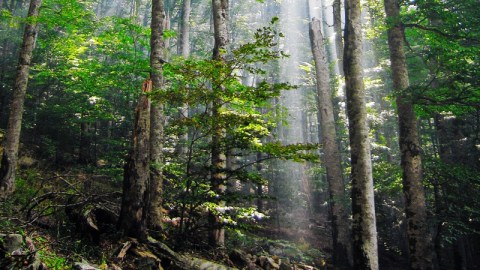“Forest Bathing”: Stress-Reducer, Immune-Booster, and Artistic Inspiration

Research into Japanese “forest bathing” offers a new and interesting take on the conventional wisdom that exposure to nature reduces stress. The term “forest bathing” is the translation of a Japanese term, Shinrin-yoku (森林浴), which refers to spending time in forests to reduce stress. Indeed, an organization of the same name refers to the practice of mindfully walking among trees as “forest therapy.” They offer this simple, healing prescription: “Go to a Forest. Walk slowly. Breathe. Open all your senses.”
The notion of immersion into nature as relaxing is commonplace enough. However, scientific researchers have found robust explanations of how trees help people to de-stress. A key part of the answer involves phytoncides, a kind of compound produced by many plants to protect against rotting and hungry animals. While discouraging to herbivores, phytoncides prove to be very helpful for humans: they not only help to reduce stress but also bolster immune function. Thus, taking a cue from the Japanese practice of “forest bathing” by taking a 40-minute stroll through the forest can have powerful physical and mental health benefits.
The power of exposure to forests is not a recent discovery. For example, a pair of German physicians in the 1800s found that exposure to forest-air helped to cure patients with tuberculosis. Nevertheless, researchers continue to reveal the multitude of healing properties of forests. A Japanese study from 2010, for instance, found that subjects exposed to forests had several favorable traits over those who were exposed to city-areas: “lower concentrations of cortisol, lower pulse rate, lower blood pressure, greater parasympathetic nerve activity, and lower sympathetic nerve activity.”
But the perksof forest bathing do not end there! Forest therapy has also been shown to improve creativity and to bolster focus. One collaborative study by researchers from the University of Kansas and the University of Utah found that subjects who hiked and camped performed 50% better on creative problem-solving tasks than those who did not; meanwhile, another American study found that 20-minute walks through parks (as opposed to downtown and residential areas) produced increases in attention among children with ADHD comparable to Ritalin.
In response to the wide variety of findings on the positive effects of forests, city-dwellers like myself may bemoan the impracticality of taking a jaunt through the woods everyday. Writer Molly Larkin, however, recommends alternative practices that function similarly. These include visiting parks, walking under trees, buying houseplants, and using aromatherapy. Thus, the potent, multi-faceted benefits of forest bathing can be accessible to nearly everyone.
—





